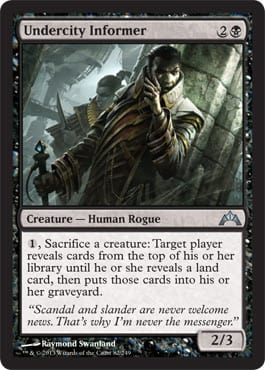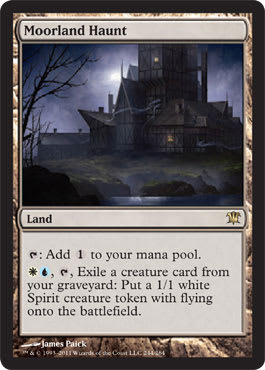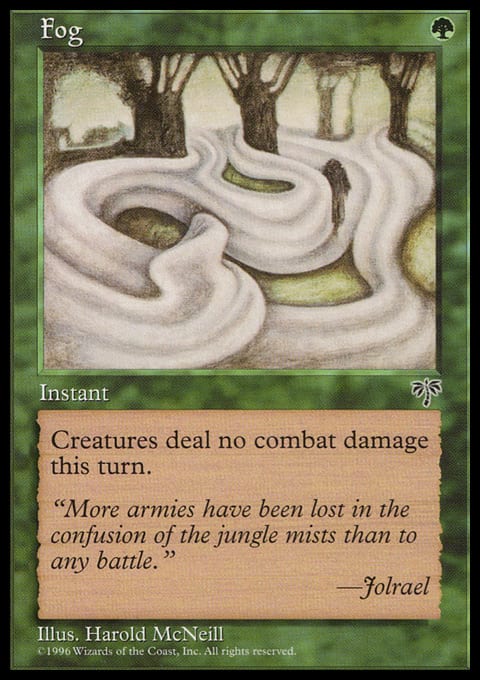You’re missing something.
Don’t worry; you’re not alone. A lot of people are missing a lot of things. That’s how you end up with a nineteen-land G/U tempo deck winning a Pro Tour Qualifier or with Undercity Informer and Burning-Tree Emissary headlining a Reanimator deck. People don’t know what they don’t know.
After the Pro Tour, I looked at strategies that had done well there but that had flown under the radar. I wrote the initial version of the article before Grand Prix: Quebec City and included Humanimator, which as you know, went on to become a major player in Standard for a time (still popping up now and then).
Another deck on that list, Sasha Markovic’s W/B/R midrange deck, was the prototype for the W/B/R good-stuff deck—Lingering Souls, Obzedat, Ghost Council, Olivia Voldaren, Dreadbore, and so on—that has become something of a fad on Magic Online.
Sure, most of those decks haven’t gained any traction since then, but the point is that there is almost always gold somewhere in the hidden alcoves of Magic tournaments—just waiting to be discovered.
Today, we’re going to do a little something different. Instead of looking at underrated, unseen, undervalued decks, we’re going to do the same for a palate of individual cards that aren’t receiving their rightful dues at the moment. For some, there are real barriers to seeing play. But for others, the only excuse seems to be the momentum Standard regularly rides forward on, the phenomenon by which we forget older cards even existed until someone brings them to the light again.
Clone and Evil Twin
Let’s start off with the inspiration for this article. Right now, the consensus best deck in Standard is Junk Reanimator, a deck chock-full of sweet value creatures that are impossible to go over the top of and a long-game (Cavern of Souls for Angel of Serenity) that is nearly impossible to beat pre-board.
Even looking beyond Reanimator, Standard is such a creature-heavy format—headlined by the power couple Mr. Thragtusk and Mrs. Restoration Angel—that you can count on playing against incredibly strong creatures in virtually every round. Even the premier “creatureless” deck of the format—Esper control—usually runs some number of Restoration Angels, Augur of Bolases, and Snapcaster Mages.
So, why are there not more Clones running around?
To be fair, Evil Twin is having something of a mini-renaissance. It is one of the best answers to opposing Thragtusks, and it’s a potentially devastating one against Angel of Serenity. Clone does the trick nearly as well in decks that don’t want black (e.g. R/W/U).
I fully plan to be playing some number of Clones in my R/W/U Flash deck.
Sever the Bloodline
Speaking of Reanimator and—I guess—of copies of the same creature, Sever the Bloodline seems wildly underplayed. Yes, 4 mana is a lot for removal, but you get what you pay for in this case. Not only are we hitting any creature (something just Murder and Dreadbore can claim), but we’re exiling and being given the opportunity to rebuy the spell later.
Plus, it makes all those Clones kind of silly. You know, once my influence completely reshapes the metagame.
The upshot is that you have a main-deckable way to gain percentage points against Reanimator. The downshot is that it’s pretty bad against Blitz-style decks and Flash. Whether that’s good enough depends on where the metagame pendulum swings on any given week.
Moorland Haunt
I get why this card left a bunch of Flash decks when Boros Reckoner became a thing, and I get that it’s less important now that people have largely abandoned Runechanter's Pike, but why are people rushing to Desolate Lighthouse in R/W/U before making Spirit tokens?
Let me give you an example. I played R/W/U at Friday Night Magic last week in what had to have been the most difficult FNM I’ve played in a very long time. There were four very good players with four very legitimate decks. Those four rounds wouldn’t have been out of place at a PTQ. In one round, I played against a Naya midrange deck that boarded in Angel of Serenity with Cavern of Souls to help trump my late-game advantage.
In the second game, after I lost Game 1, he resolved Angel of Serenity and picked up Thragtusk, Huntmaster of the Fells, and Restoration Angel from his graveyard. In other words, if I ever killed it, I was probably dead. My chances of not dying with a 5/6 flyer in play for multiple turns wasn’t great either. We were also both at pretty high life totals, but I had no board presence at all.
What I did have was Moorland Haunt.
So, over the next few turns, I chump-blocked with Spirit tokens while flashing in Restoration Angels to attack back with and resolving the odd Sphinx's Revelation. And despite him attack me for about four or five turns with a 5/6, I ended up pulling ahead in the race and eventually forced him to sit back with his Angel. I eventually won without ever killing the mythic 7-drop.
We used to play multiple Moorland Haunts in these decks, and that was before the mana was improved even more by Sacred Foundry. So, now that we’re not on Boros Reckoner anymore, why are we passing on virtually free 1/1s that can be played at instant speed? Victor Fernando Silva—spiritual/online father of the six-counterspell, no Thought Scour version of R/W/U—went so far as to play twenty-six lands and sixty-one cards so as to not miss out on Moorland Haunt.
Ground Seal
For some reason, only Reid Duke seems to be in on this one. There are enough decks out there that do something with the graveyard that main-decked hate isn’t completely out of the question, even for something as narrow as Rest in Peace. Ground Seal is, at the very least, a cantrip. At most, it’s a complete hosing of the best deck in the format. Any deck that can afford to play some should at the very least consider it.
Planeswalkers
Planeswalkers are generally underplayed in just about every deck except Jund, which plays two of the best. But a few of the others have applications in the current metagame that are being overlooked.
Tamiyo, the Moon Sage is a nice little answer to Thragtusk and Reanimator as well as Nephalia Drownyard. Obviously, she has issues with haste creatures and Restoration Angel, but Blind Obedience could mitigate some of that damage.
Jace, Architect of Thought still isn’t as great as I want it to be, but there’s some wiggle room on this one. For one, Assemble the Legion is a real card, and Middle Jace is actually among the best answers to the game-breaking enchantment.
Also, I have a foil one just sitting in my binder, and I want it to be worth something ridiculous, so if you would, buy all of the Jaces.
Speaking of foils I can’t get rid of, Vraska the Unseen is seeing a slight uptick in play. And by “slight uptick,” I mean it has been seen once or twice instead of the zero times that have defined its entire run in Standard. It has some applications in the Reanimator mirror because it lets you fight the opponent’s Angels without expending a card, which is somewhat important. If you’re looking for a 5-mana Vindicate with upside, I guess this is your card.
But if you really want to be serious about going over the top, nothing goes over the top quite like Nicol Bolas, Planeswalker. While the eldest of dragons isn’t even as big as you can go in this format (that title belongs to Omniscience), he’s still pretty big and slightly more realistic to cast for a control deck. I’ve had a few friends try to wedge force cram make this work in four-color control decks, but results have been mixed.
Fog
Because you sometimes just need one more turn to turn it all around. And sometimes, even 8-mana mythic Beasts become a little lost in the Fog. I mean, it’s hard to be all tramply when you can only see a few feet in front of yourself.
Cheap removal is hard to come by these days, and even then, that which we have is quite conditional. All Fog requires is that the opponent plays creatures that attack, which is, basically, everything.
One of the guys in a forum I belong to—a rangy deck-builder who has a Grand Prix Top 8 to his credit—is currently testing out a Fog-based Bant deck that finishes the game with planeswalkers. Because the planeswalkers gain value every turn, the deck can afford to throw away cards on Fog to stall. Fog also encourages players to build up their boards, which plays right into both Wraths and Tamiyo, the Moon Sage.
Murder and Victim of Night
We all keep screwing around with Pillar of Flame, Searing Spear, Ultimate Price, and the like and then complaining that our removal doesn’t hit everything we need it to hit.
You know what does? Sever the Bloodline and Murder. And, to a lesser extent (Read: Olivia Voldaren and Vampire Aristocrat), Victim of Night. Sever we already covered, but these two . . .
Granted: There’s a world of difference between 2 and 3 mana.
Granted: ![]()
![]() is harder to generate than
is harder to generate than ![]() .
.
Granted: Black is pretty bad right now outside of Unburial Rites and Grisly Salvage.
But . . . hitting everything is much better than hitting most of the things or some of the things. Jund is doing it right with a few Murders, but I think we can do better.
Duskmantle Seer
Because, mise, right?
But, seriously, this guy severely punishes Reanimator. Nice Angel of Serenity; take 7. Craterhoof Behemoth? Take 8. Even “just” Restoration Angel and Thragtusk are pretty big beatings.
Oh, and it attacks through Restoration Angel.
Just saying: The time might be right. Again.
Random Things I’m Thinking
Things I’m thinking, in no particular order, with no relevance to, well, much of anything.
- A Modern proposal: Vivid lands as Modern Masters common fixing
- I’m something like 87–5 with Orzhov in Gatecrash and something like 5–87 with anything else.
- Is it really a maze if you’re going through well-known, pre-defined locations like, I don’t know, the gates of ten guilds?
- Another Modern proposal: Ban everything till Reveillark is the best strategy. Then enjoy Reveillark.
- Candyland is a game the way I play it.
- I’m changing my Facebook profile photo to Duskmantle Seer to show my support for the cause.




























